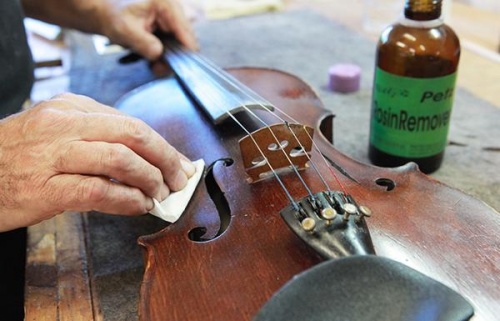Looking after your violin

Looking after your violin/fiddle.
With careful handling, a violin can survive for hundreds of years. However, the tone from your violin is affected by a number of variables including ones that are difficult to control (eg) temperature and humidity! I have heard numerous recounts of musicians who left their treasured instrument in a car on a sunny day only to return to something that no longer resembled a violin! It is very sad when this happens, and in some cases a repair is not feasible.
Where to store your violin
It goes without saying, that where you store your fiddle is important; keep clear of radiators when at home and out of direct/strong sunlight when at a Feis or festival.
Falls/Knocks
If your violin falls to the ground, it is likely that the bridge position will be affected or worse still, a crack to the spruce top may result. A bridge can be easily replaced, but a crack to the violin will be more difficult. Often, the violin will need to be opened and need glued and restudded / cleated internally. To guard against such falls, ensure your fiddle is returned to its case when not being played.
Cleaning and Polishing
A violin should ideally be cleaned after every use. Using a soft cloth, wipe rosin from the fingerboard and under the strings, this will prevent a build up over time which will prevent it breaking down into a gum like residue.
Don't be tempted to use furniture polish as these contain solvents which damage the varnish over time. Instead, use a slightly damp paper towel to clean skin acids and other soluble substances but make sure to wipe it dry again quickly.
The Bridge
Players should monitor the position of the violin bridge so that it remains straight (perpendicular) to the top. Over time, tuning the strings will pull the bridge forward (or back, if using fine tuners). This can cause it to lean and become warped. If this has already happened, your violin's tone will be suffering and a new bridge will need to be properly fitted in a violin shop. In addition to warping, strings can sometimes cut down into the bridge (especially the E string). This also deadens the vibration of the string and will most likely require a bridge replacement.
Of course, by ensuring your bridge remains standing at an angle of 90 degrees to the violins top plate will prevent such problems from occurring in the first place.
The Tuning Pegs
If your violin is hard to tune or the pegs jump when tuning, you can try putting some stick lubricant (such as Hill's Peg Paste) on them. This will help them to turn more freely inside the peg holes. On the other hand, if the pegs are slipping, try applying some peg paste. If the issue persists, it may be likely that you need your pegs shaved or replaced, or perhaps the peg holes tapered, which can be rectified very cheaply at a violin workshop. Never try to force pegs into the holes to correct slippage, as this can cause serious damage to the peg box (particularly on the A String). This can be more costly to fix.
Open Seams and Cracks
If your violin has an open joint or seam, this will be very detrimental to the tone of your instrument as much of the vibrations travelling throughout the body of the violin are escaping through the open seam, instead of out through the f holes. Open seams should be glued as soon as they are noticed.
The top plate / belly of the violin carries a lot of pressure (75 pounds / 6 stones of along the length of the violin) which truly tests the strength of the neck joint; and 25 pounds / 2 stones of downward pressure at the bridge. Understandably, if there are weaknesses or cracks forming, these are going to eventually give way and the top plate, which is made of spruce may collapse. Over time, the residue from rosin, dirt, oils from skin will make a repair much harder and visible.
Servicing your violin
An annual service of your violin is a worthwhile investment long term, particularly if it is a valuable instrument. A violin luthier will clean old residues of rosin and dust, check string action, redress the fingerboard if needed and ensure pegs are moving freely.

